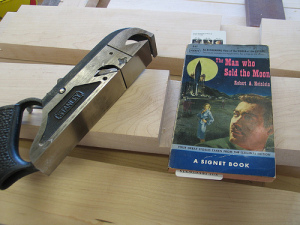
Book Review: The Man who Sold the Moon
This is one of several hundred very old sci-fi paperbacks my folks were dispensing with a few years back. I couldn’t bear to let them go, although I don’t know that I will live long enough to read all the books I have now. I like what I have read of Heinlein, so I grabbed this one for a quick diversion.
The Man who Sold the Moon is actually a collection of short stories. The copy I have is a signet paperback, published in March of 1951. The pages are yellowed, the cover had to be reinforced with some scotch tape, and it’s got that funky old book smell. But, it was nothing that stopped me from reading it!
 The beginning of the book contains a big timeline chart, showing the “future” (some of which has actually already transpired since the writing of the book) and chronologically associates stories, events, and technological developments from 1975 to 2600.
The beginning of the book contains a big timeline chart, showing the “future” (some of which has actually already transpired since the writing of the book) and chronologically associates stories, events, and technological developments from 1975 to 2600.
This timeline is fairly meaningless to the reader until reading the book. However, the preface sheds some light on its inclusion. Evidently Heinlein borrowed the idea from Sinclair Lewis. Heinlein didn’t inititially tell anyone about it, but nonetheless felt constrained to write in conformance with it over the course of 10 years. He alludes to this being a two-edged sword with the quotation at the start of the preface. “It does not pay a prophet to be too specific.” L. Sprague de Camp.  The Man who Sold the Moon contains 4 short stories, and as it turns out, is one of several books in the series (and, fortunately for me I seem to have them all).  What’s interesting about these stories is that they are only related in as much as they transpire within the same universe. Each story features its own set of characters and builds on the technological or societal events referenced in the others, but is otherwise a stand-alone work.
Let There Be Light is the first story and is a little campy. I thought it was the weakest of the lot and felt that the dialog in particular was stilted and phony. It was short and mostly painless, so I moved on to the next story, hoping for something better. The Roads Must Roll did not dissappoint! I REALLY liked this story. Heinlein creates a philosophy called functionalism that is kind of reminiscent of the present day concept of “too big to fail”.  He also has an interesting way of presenting his hero in a surprising way. At first you think that the bad guy is the good guy, and that the hero is at best a bureaucrat. This story was really well done. The Man who Sold the Moon is the longest of the stories and is also extremely well done. Heinlein clearly understands advertising, and does a great job with the character Harriman. Requiem is a very short snippet of continuing the life of Harriman, and feels almost like an epilog to the The Man who Sold the Moon.
This collection is definitely worth reading. I’m working on the next one, The Green Hills of Earth.
 The posts are coming!
The posts are coming!


0 comments
Kick things off by filling out the form below.
Leave a Comment